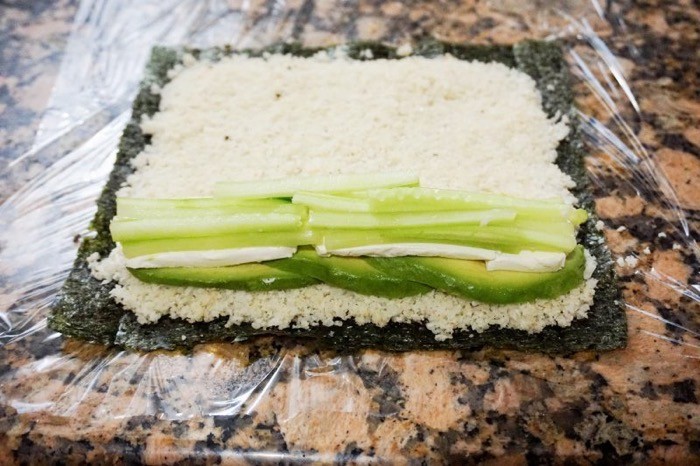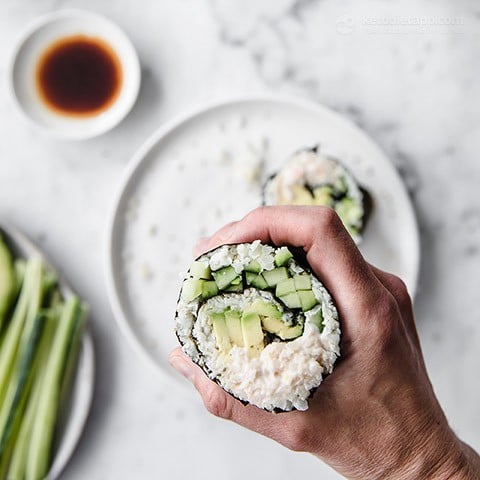Sushi on keto? Heck yeah! But not so fast, not every “type” of sushi is considered keto-friendly, at least in a non-technical sense.
If there are two things I could choose to eat before I die, it would either be sushi or Korean Barbecue (KBBQ).
Seriously, if you were to ever eat with my family, you already know where we're going to go on a night out or to celebrate someone's birthday. However, sushi will forever get my #1 spot.
Is sushi keto-friendly? By definition, sushi is vinegar rice topped with other ingredients, making sushi not keto-friendly, because rice is primarily a carbohydrate. However, certain types of “sushi,” known to the Western world, such as sashimi, which is raw slices of fish, do not contain rice and is considered keto-friendly.
In this article, I'll go over which types of keto sushi you can eat on keto or low carb, and which to avoid. I'll then discuss how many carbs are in your average sushi roll, the different kinds of sushi, and possibly other items you can eat on the menu at a Japanese or sushi restaurant.
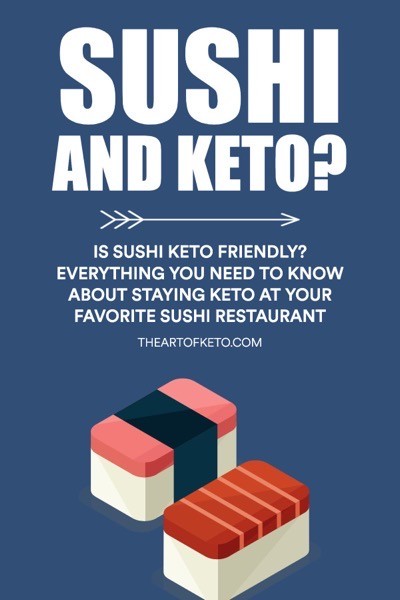
Table of Contents
Is Sushi Considered Keto?
By the most traditional of senses, sushi is not considered keto.
Most people may associate sushi with being raw fish, but sushi, by definition, is cold rice dressed with vinegar, which then can be garnished with anything. However, most sushi will contain either raw fish, vegetables, or egg.1
But let's forget the technicalities because we want to eat some low carb sushi… or whatever it's called.
What then can we eat when we head out to a sushi or Japanese restaurant on keto? Follow along, and I'll break down everything you can order at your favorite sushi or Japanese restaurant, including the appetizers.
Is Sushi High In Carbs?
Traditional sushi is quite high in carbohydrates, and the same goes for sushi rolls. Both sushi and sushi rolls contain rice, which is generally seasoned with additional sugars, making it not ideal for a ketogenic diet.You're unlikely to find the nutritional information of sushi posted at your local restaurant, but your average order of nigiri, which is usually two pieces of raw fish atop two balls of rice, has about 17grams of carbs per order (2 pieces) 2
Granted, this number may vary from restaurant to restaurant, mainly since different restaurants use different amounts of rice per piece, but it's a reasonable estimate.
When I typically eat out, I like to overestimate, so I would likely assume every piece of nigiri has 10 grams of carbohydrates.
How many carbs are in a sushi roll? A typical sushi roll is generally cut into six or eight pieces and contains about 1/3 cup of sushi rice uncooked or 1 cup cooked. Without taking into account any added sauces to the roll, your average sushi roll will have about 65 grams of carbohydrates. 3
How many carbs are in a sushi roll without rice? Without rice, a sushi roll would only get trace carbohydrates from any vegetables and the nori (seaweed). Without taking into account any sauce a roll may have, you may expect 2 to 3 net grams of carbohydrates for a sushi roll without rice.
What Is Sushi?
Just to reiterate, sushi is technically the rice, or at least to describe the rice portion.
Sushi comes from the Japanese word meaning “sour rice,” making the rice portion of the dish the real star of the show. Most of the Western world think of sushi as the raw fish or what is called a sushi roll.
You may also be surprised to learn that initially, sushi arose in China as a way to preserve food.
Salted fish was placed in rice and allowed to ferment, and then the rice was discarded before eating the fish. It wasn't until the Japanese took this concept and began to eat the rice with the fish.
It wasn't until the early 17th century that the seasoning of rice began, and not till the early 19th century that instead of wrapping the rice, the fish was placed on top, giving us what we know as nigiri sushi today.
For simplicity, sushi can generally be categorized by three different types. Those are:
- Nigiri
- Sashimi
- Maki
Nigiri
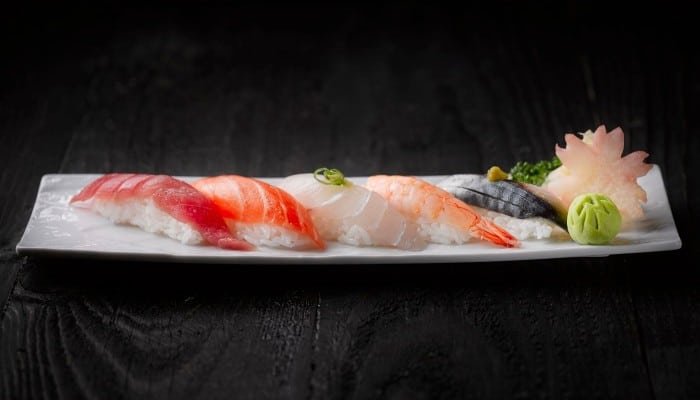
Nigiri is a style of sushi that is made by taking a ball of vinegar rice and topping it with either raw fish, vegetables, or eggs (Tamago).
Most sushi restaurants will serve nigiri in pairs, though some do sell and price it by piece.
Due to the carbohydrates in the rice, nigiri isn't considered keto-friendly. Still, it can make an excellent option for those following a cyclical ketogenic diet or implementing carbohydrate refeeds of any kind.
However, at some sushi restaurants, you can make it low carb keto by substituting cauliflower rice, thus making it keto sushi (or nigiri to be precise).
Sashimi
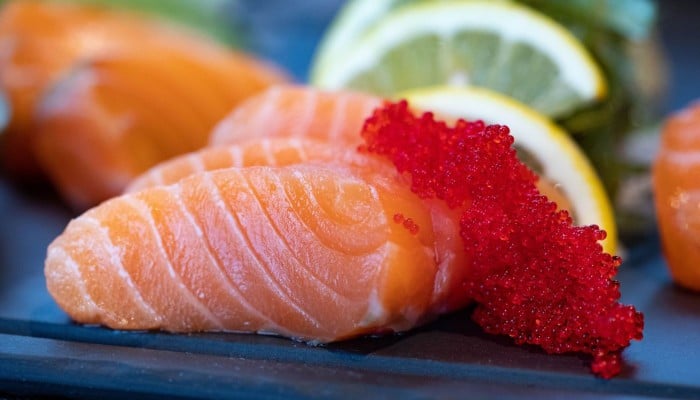
Sashimi is simply raw fish, served as is. Most restaurants will serve sashimi in long rectangular slices paired with ginger and wasabi on the side, and possibly some grated daikon (a type of radish).
Sashimi is considered keto-friendly, and so is the grated daikon that it may be served with.
On the other hand, the ginger they serve at sushi restaurants is more than likely pickled in a sugar-filled solution, and it may be best to avoid or limit your consumption.
Sashimi is low carb, often no carb, and thus can be considered a keto sushi.
Maki
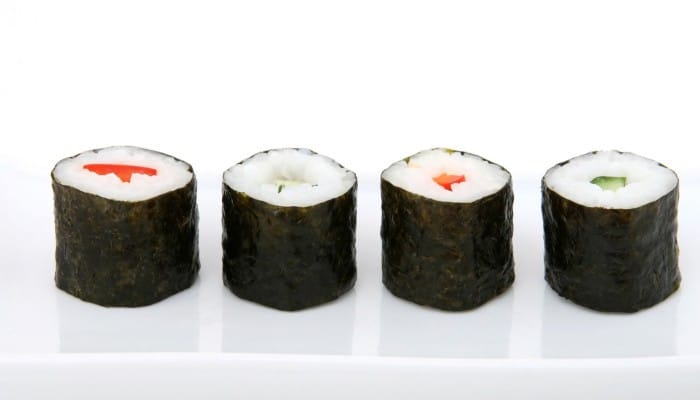
The most traditional type of maki is a sheet of nori (seaweed) wrapped around a layer of rice, fish, and sometimes vegetables like cucumbers.
The fish is then cut into six to eight pieces and served in this manner.
In this category, most people are familiar with futomaki and temaki. Futomaki is the larger sized rolls filled with a random assortment of ingredients while temaki is what you may know as hand rolls.
Most maki is not considered keto-friendly. However, sushi restaurants are starting to come out with rolls that do not use any rice at all, using just cucumber or fish as a wrap and stuffing more fish with it.
Another option is if they let you substitute cauliflower rice, which would then make it low carb.
It may be possible to make a maki roll keto-friendly, but most will still have imitation crab and/or added sauces which are not as keto-friendly then having only seaweed with fish, vegetables, or a combination thereof.
What Sushi Can I Eat On Keto?
Now that you have an understanding of the different “types” of sushi, which sushi can you eat on a ketogenic diet at a sushi restaurant?
Your best bet will always be sticking to sashimi if you're a fan of raw fish. Unfortunately, nigiri and 99% of sushi rolls have too many carbohydrates if staying in a metabolic state of ketosis is essential to you.
Sashimi + wasabi + a little bit of soy sauce = keto diet heaven
Appetizers at a sushi restaurant on a keto diet
While the menu at your sushi or Japanese restaurant will vary, here are some popular appetizers that may be keto-friendly.
I say MAY be keto-friendly because depending on where you are, they may serve any one of them battered and/or with sugary sauce on top.
Make sure you ask your server before ordering any one of the below to see if you can have them without added sauce or breaded to ensure the least amount of carbohydrates.- Shishito peppers
- Mussels
- Oysters
- Chicken or beef skewers (yakitori)
- Kama (salmon or yellowtail collar)
- Miso soup
- Jalapeno poppers
- Tako (squid)
- Carpaccio
Main dishes at a sushi restaurant on a keto diet
For main dishes, stick with a protein like fish, chicken, or beef. The meats are likely marinated, but it's your best option if you don't like sashimi.
Certain Japanese restaurants specialize in yakitori, which are meat skewers. Simply ask for any sauces, if any, to be removed or placed on the side.
- Sashimi (basically any)
- Chicken (hold the sauce)
- Beef (hold the sauce)
- Eel (hold the sauce)
Drinks at a sushi restaurant on a keto diet
Here are some keto-friendly beverages you may enjoy with your sushi or other Japanese cuisines.
Yes, you read that correctly. Sake may be enjoyed in moderation when following a ketogenic diet.
- Water
- Sparkling water
- Tea
- Diet soda
- Sake
How To Order Sushi Without Rice
If you're interested in ordering nigiri, which is raw fish on top of rice, order sashimi instead. By ordering sashimi, you will only be getting slices of fish without the rice.
Sashimi will typically be served with some ginger, wasabi, and sliced daikon. Just don't go crazy on the ginger since there's usually added sugars from the pickling process.
Aside from that, there may be a possibility that the restaurant is willing to customize a roll for you if you ask them to make it without rice.
I've asked for rolls to be made without rice and sauce. I have yet to be turned down by my request.
Some sushi restaurants are also starting to come out with no rice rolls, but be wary of ones made with too much imitation crab or have added sauces (which is just about every roll).
Basically, you'll want a nori sheet with some veggies and fresh fish to be on the safe side. Spicy tuna can work, but be wary of the net carbs as they begin to add up. Add an appetizer (or dessert) of miso soup and you're good to go.
Is imitation crab keto-friendly? Imitation crab is moderately keto-friendly on its own in small quantities, but some sushi restaurants add starches or sugar, which will increase the carb count. On its own, imitation crab meat contains 11 grams of carbohydrates per half-cup serving.
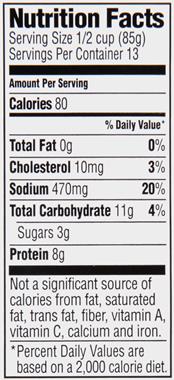
If dining at a sushi restaurant, always try and opt for real crab meat when ordering rolls with crab a.k.a (k)rab, or as my girlfriend and I like to call it, crab with a K.
The chances are unless it says “real crab” on the ingredient list, they are using imitation crab meat.
What To Avoid At A Sushi Restaurant On Keto
Here is a basic list of items you should try to avoid when dining out at a sushi restaurant while trying to follow a ketogenic diet.
- Nigiri
- Sushi rolls
- Sauces
- Tempura fried anything
- Noodles
- Gyoza (dumplings)
- Rice
Of course, there may be exceptions, as I mentioned briefly in this article. Some people, mostly athletes or highly active individuals, choose to follow a cyclical approach to a ketogenic diet.
A cyclical ketogenic diet is typically alternating days of standard ketogenic dieting with days of higher carbohydrates. For example, one would follow five days of strict ketogenic dieting followed by a two-day “carb load.”
Bear in mind, this type of protocol also generally follows a pretty rigorous and well-thought exercise regimen that ensures the carbohydrates are stored as muscle glycogen and doesn't spill over into fat cells.
For those that are following this type of approach, sushi on keto, especially nigiri, makes excellent carb-up food. During the carbohydrate loading phase, you want your fats to be reduced as much as possible to compensate for the increased carbohydrates and prevent any unwanted fat gain.
Again, it is a pretty rigorous protocol and not for the faint of heart.
However, some do choose to have mini carb-loads every once in a while as a way to provide a mental break from dieting or simply enjoy time with family and friends.
For these individuals, I would still recommend fat intake be kept moderate to low for an “optimal” carb-up or “cheat day.” However, if only doing so once in a blue moon, then do as you please.
It's what you do MOST of the time that will net you the most significant result, and not what you do once in a while. Just like eating a single salad won't make you lose weight; eating a single unplanned meal will not make you fat.
That is, of course, unless it leads you to binge.Keto-Friendly Sushi Recipes
If you want to get a little creative at home, here are a few keto-friendly sushi recipes to try at home. I've included a way for you to make some mock “sticky sushi rice” as well using cauliflower as a substitute.
Keto sushi
This recipe uses a medium avocado, cream cheese, and cucumber as a filling. I am not the biggest fan of cream cheese in rolls, but my mom and sister-in-law love them.
Neither of them is keto, but when I made these, they were big fans.
Simply substitute the cream cheese for some fish or even meat if you desire. If you want a little bit of a crunch, adding in some bean sprouts works great.
Photo and recipe courtesy of Keto Connect
Keto-friendly sushi rice
Want an excellent recipe for keto-friendly sushi rice? Use this recipe or other keto recipes that utilizes coconut milk or coconut water for a unique texture and flavor. Also, a splash of some rice vinegar and sesame seeds can go a long way without adding very many net carbs per serving.
Recipe courtesy of The Castaway Kitchen
California sushi burrito
Sushi burritos and hand rolls are all the rage these days.
I feel like sushi burritos are popping up on almost every corner, and for a good reason, burrito + sushi = genius.
Throw in some smoked salmon (or raw) if you like. Salmon avocado is my go-to filler, make sure you give it a try!
Photo and recipe courtesy of Keto Diet App
Rather follow along and watch step by step on making an easy keto-friendly sushi roll? Give the below video a watch.
The Takeaway
Unfortunately, most sushi on keto is not keto-friendly, except for sashimi, which is merely raw slices of fish. If it were me, I like to make keto easy when I dine out by ordering some sashimi, soy sauce, and a side of miso soup.
Sushi on keto doesn't have to be complicated.
However, there are more and more Japanese restaurants that are coming out with “no rice rolls,” which may offer another alternative. Make sure you ask if you can make alterations to some rolls if they don't see anything suitable.
Simply be mindful of the imitation crab and any added sauces as they can easily throw you over your carbohydrate allotment for the day.
Frequently Asked Questions
What is riceless sushi called?
“Riceless sushi” isn't something that actually exists. The two best options are Sashimi and Naruto. These both are rice free and are the most keto-friendly way to eat sushi.
What are the healthiest types of sushi?
When it comes to sushi, while it may be healthy it's not necessarily keto friendly. The safest bet while you're on the keto diet is to consume Sashimi
Why is sushi rice so high in carbs?
Sushi rice is high in carbs because it's coated with sushi vinegar. Sushi vinegar is typically a combination of vinegar, sugar, and mirin. It's essentially why sushi rice is so high in carbohydrates.

